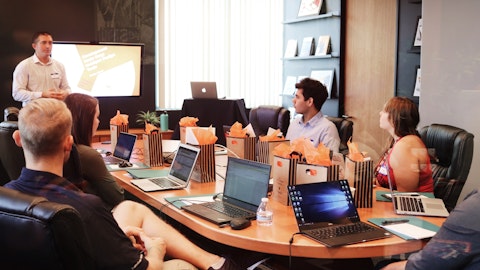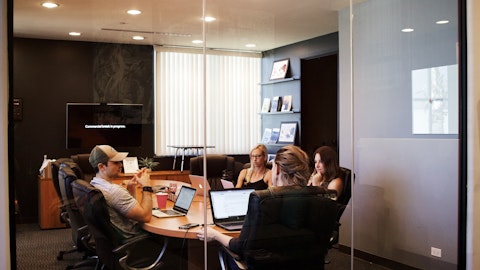John Bean Technologies Corporation (NYSE:JBT) Q1 2023 Earnings Call Transcript April 26, 2023
John Bean Technologies Corporation beats earnings expectations. Reported EPS is $0.94, expectations were $0.73.
Operator: Good morning, and welcome to JBT Corporation’s First Quarter 2023 Earnings Conference Call. My name is Audra, and I’ll be your conference operator today. As a reminder, today’s call is being recorded. I’ll now turn the call over to JBT’s Vice President of Corporate Development and Investor Relations, Kedric Meredith to begin today’s conference. Please go ahead.
Kedric Meredith: Thank you, Audra. Good morning, everyone and welcome to our first quarter 2023 conference call. With me on the call is our Chief Executive Ofiicer, Brian Deck; and Chief Financial Ofiicer, Matt Meister. In today’s call, we’ll use forward-looking statements that are subject to the safe harbour language in today’s press release and 8-K filing. JBT’s periodic SEC filings also contain information regarding risk factors that may have an impact on our results. These documents are available in the Investor Relations section of our website. Also, our discussion today includes references to certain non-GAAP measures. A reconciliation of these measures to the most comparable GAAP measure could be found in the Investor Relations section of our website.
Now I’ll turn the call over to Brian. Brian Deck Thanks, Kedric, and good morning, everyone. Overall, we outperformed our expectations in what is typically JBT’s seasonally slowest quarter of the year. As we have said before, FoodTech continues to be driven by a resilient business model, a diverse product offering, and value-added acquisitions. In the first quarter, FoodTech revenue and margins exceeded our guidance, largely on the strength of recurring revenue. At AeroTech, we’re no longer on a path to recovery where we are there, with exceptional demand and record orders in the quarter. With that, I’ll turn the call over to Matt to provide details on the first quarter and outlook for the second quarter.
Matt Meister: Thanks Brian. JBT delivered solid Q1 results with double digit year-over-year growth of 13% on revenue and 30% on adjusted EBITDA. At FoodTech, revenue increased 9%, with growth of 2% organic and 10% from acquisitions, partially offset by a 3% negative foreign exchange impact. The year-over-year growth exceeded our guidance due to the strength of recurring revenue, which represented 56% to total revenue in the quarter, and an improving supply chain environment enabling the delivery of more product than forecasted. FoodTech adjusted EBITDA margins of 18.1% improved 180 basis points over the prior year, driven by the favorable mix of recurring revenue and continued improvement in price cost. At AeroTech, first quarter revenues increased 25% and adjusted EBITDA margins of 10.1% improved 300 basis points from the prior year period.
AeroTech’s year-over-year margin expansion resulted from volume-driven leverage on fixed costs and the realization of pricing actions. On a JBT consolidated basis, adjusted EBITDA increased 30% or $16 million in the first quarter of 2023 to $70 million. Adjusted earnings per share was $0.94 compared with $0.88 in the first quarter last year. A strong operating performance was partially offset by higher depreciation and amortization, higher interest expense, and a lower discrete tax benefit. For the second quarter of 2023, we anticipate total year-over-year revenue growth of 5% to 9% and adjusted EBITDA margins of 14% at the midpoint, or an improvement of approximately 200 basis points. At FoodTech, we expect revenue growth of 5% to 10% with adjusted EBITDA margins of 18 and three quarters percent.
At AeroTech, we are projecting revenue growth of 4% to 7% in adjusted EBITDA margins of 10% and three quarters to 11% and three quarters percent. As a result of this, continued top line growth and margin expansion, we project second quarter GAAP earnings per share of $0.90 to a $1.5 and adjusted EPS of a $1.10 to a $1.25. For the full year, our guidance is essentially unchanged with consolidated revenue growth of 7% to 10% and adjusted EBITDA growth of 23% or 170 basis points at the midpoint. We still expect free cash flow conversion to be above a 100% of net income for the full year. With that, let me turn the call back to Brian.
Brian Deck: Thanks, Matt. As we discussed last quarter, the backdrop of economic uncertainty remains a factor in the pace of FoodTech customers’ investments decision making, as does the cost and availability of capital. With that in mind, FoodTech orders of $406 million or $417 million on a constant currency basis met our expectations. We were encouraged by further stabilization in Europe, particularly in Southern Europe, while North America moderation persisted. Asia remains inconsistent and the Middle East and Africa showed continued strength. Overall, we remain encouraged by the engagement with FoodTech customers entering the second quarter as they continue to be motivated by the need for automation, operating efficiency and sustainability.
In terms of end markets, we enjoyed healthy order trends from food and fruit and vegetable, convenience meals and ready to drink and functional beverages, and we witnessed some modest sequential improvement in poultry investments after declines in the back half of 2022. However, this market generally remains under pressure. Lastly, our automated guided vehicle business continues to enjoy strength and demand. Since our last call just two months ago, we have continued to sign customer contracts for our digital solution OmniBlu. Omnibus proposition is resonating with customers and we remain excited about its potential for deepening our customer relationships. Our internal technical and support teams are fully built, and with the core product development stage largely behind us, we are increasingly focused on commercialization and we’re working side by side with customers to continually enhance the product.
Moving on to AeroTech, orders expanded 51% year-over-year to a record, $232 million, $50 million above any prior period, with improved price recovery and robust demand across the infrastructure and commercial airline and markets. Regarding our intent to become a pure play food and beverage solutions company, last quarter, we indicated separation is more likely to be realized through the sale of AeroTech. Indeed, this is the path we are pursuing. Our intent remains to be to execute by year end, while remaining cognizant of the capital market environment. In the meantime, with a recovery in the commercial air demand, growth and defense applications and continued robust airport infrastructure spending, AeroTech’s backlog reached an all-time high and we are quoting well into 2024.
Finally, I’d like to talk about JBT’s corporate responsibility and sustainability initiative. Last week, we issued our 2022 ESG Annual Report, sustainable solutions for a growing world. As the population expands, we need sustainable solutions to feed the future. JBT has those solutions today, enabling customers to enhance food yield, quality and safety while reducing food and packaging waste. Our technologies also reduce the use of precious energy and water resources, while cutting operational emissions. We believe JBT’s dedication to sustainable future will leave a positive legacy that can truly impact future generations. In 2022, we estimate that more than 70% of JBT’s products and service revenues stem from equipment that delivered environmental benefits.
Sustainability and profitability are not mutually exclusive for JBT and our customers. Our solutions have always been built around enabling customers to reduce food production costs and improve profitability. OmniBlu further supports customer profitability and resource utilization through next level data intelligence that improves equipment efficiency and uptime. These sustainable solutions make JBT more competitive and critical to the food industry. JBT is also supporting the development of sustainable foods with solutions for production of plant-based proteins and dairy alternatives. Moreover, we’re helping food and innovators with cell-based protein production, which can revolutionize the way food is produced. We recently joined a number of initiatives around the globe, reflecting our commitment to sustainability.
For example, by partnering with the World Climate Foundation, JBT joins a network of organizations, committed to accelerating the transition to a low carbon climate-resilient global economy. Of course, none of our growth progress would be possible without JBT’s highly skilled and engaged workforce. This year I signed the CEO Action for Diversity and Inclusion pledge, reflecting our ongoing commitment to diversity, inclusion, equity and belonging. We launched and grew our first two employee network communities, employee led teams that foster diverse and inclusive workplace aligned with JBT’s core values, and I am particularly proud of the progress we made this year, increasing the representation of female and minority leaders at all levels of the organization, I sincere thank to all employees across the globe.
With that, we’ll take your questions. Operator,
Operator: Q – Mircea Dobre Thank you. for taking the questions and good morning, everyone. I guess we’re I would like to start is with a little more color maybe on what you’re seeing in terms of FoodTech demand trends. I’m curious the protein business, how you see that progressing through the year, and I’m also curious from a pricing standpoint, how things are changing and where you sort of think you are on a price cost balance at this point.
Q&A Session
Follow John Bean Technologies Corp (NYSE:JBT)
Follow John Bean Technologies Corp (NYSE:JBT)
Brian Deck: Okay. So from a demand perspective, I would say it’s still mixed across the globe. We’re seeing regional strengths and weaknesses right now, as I mentioned, Europe is a little bit stronger. North America, some of the moderation persisted. It was stronger in the fourth quarter, sorry, in the first quarter, versus the third quarter last year, but not quite as strong as the fourth quarter. And that’s immediately driven by poultry and even the pork industry. Both of those are a little bit challenged right now. What we’ve seen in Europe, if you recall the first half of last year, we saw some deferred investments in lower demand and typically what we see, and it played out in this case is that our customers can typically only go a couple quarters before that drumbeat of food demand ultimately requires some investment and that, and that’s what we think we’re seeing there.
And ultimately we think that will play out in North America as well, but at this point, North America is lower than I would say the normal baseline. As it relates to price cost, we are seeing — we’re getting to that upward limit on pricing, generally speaking. That said, we remain in a inflationary environment. We will continue to make sure we capture our increased cost, but there’s certainly more pressure on pricing than there’s been in prior quarters. That said, we feel we can maintain our margin profile. Q – Mircea Dobre Understood. Then maybe follow up on your guidance, obviously, the quarter played out quite a bit better than the way you initially guided. You are not really carrying the Q1 beat to the full year outlook. So maybe a little bit of commentary as to what is unique in a quarter that perhaps doesn’t repeat on a go forward basis and really any other puts and takes to, to the outlook, relative to what you previously expected.
Brian Deck: Sure. There were two things to primary contributors to the quarter. First, we did have about $5 million of equipment revenue that moved out of Q2 and into Q1. As we mentioned, a little bit better supply chain environment that allowed that. That certainly won’t continue and we had pretty extraordinary recurring revenue business in the quarter. We think that’s going to moderate back to normal levels we’ll see, Obviously, we’ve got a great recurring revenue franchise and continue to be a source of strength for JBT, regardless of the economic environment. So we’ll see how that plays out. But that said, we are really cognizant and aware of the broader economic environment and how that might impact how we go forward from here.
We do have a large, relatively large go-get still, we’re reasonably well positioned in our backlog, but there still is go-get on our revenue. And, our margins obviously performed well, but there’s, in this economic environment, we didn’t feel that this was an environment for raising guidance. It’s just really a just being very cognizant of where we sit in the market. Q – Mircea Dobre And just to put a finer point on the recurring revenue, what was it in a quarter that maybe boosted this portion of the FoodTech business that you don’t expect to be sustainable on a go-forward basis?
Brian Deck: Well, just history and data, data history would tell us, you have fits and starts sometimes. If you recall, I think it was third quarter last year, it declined for one quarter and it rebounded, and this one spiked. And, I will say what was pleasing, however, it was, it was strong globally. Every economic region showed strength in in aftermarket. Obviously we hope that continues, but historically the data would suggest that it goes back to normalized levels. Q – Mircea Dobre Okay. Thank, thank you for the questions.
Operator: We’ll go next to John Joyner at BMO Capital Markets.
John Joyner: Excellent. Thank you very much for taking my questions. So Brian, just maybe to follow up on the point about the poultry markets, and maybe this is probably an easy one, but there has been some stabilization there and gradual improvement in poultry prices in North America. Is that starting to help sentiment at all with the customer base kind of compared with the beginning of the year, or is it too early to tell?
Brian Deck: It’s a little early, but we did have an improved quarter on poultry investments. That was nice to see. It’s hard to know if that’s how sustainable that it will be. Like I said, it did improve in the quarter, which was nice to see. We’ll see where we go from here. I agree that there is some stabilization, but you’re — but where it sits today is still relatively low in the grand scheme of things despite the improvement, and I know that there’s a lot of work by our customers working on the efficiency. Side of things, I don’t expect the kind of demand from the equipment perspective on new capacity. It’d be more about the operating efficiency, and that’s what some of the orders that we saw in the first quarter reflected.
John Joyner: Okay. That’s a good color, thank you. And then just regarding the ongoing rollout of OmniBlu across your product portfolio, I believe that last check you had around five connected product lines. You can correct me if that’s not right today, but because OmniBlu is a big focal investment for JBT and is there any update on any other product categories that are now connected and you kind of mentioned this a little bit earlier, but what has been the kind of the early feedback so far from customers?
Brian Deck: Sure. So yeah, we are in five product lines that have been introduced in the six that we’re getting closer on. A couple of product lines are fairly well developed and two less well developed in starting the commercialization. In terms of the feedback, customers are telling us that, OmniBlu is a differentiated product, which is really what you want to hear. It’s it making us a more engaged vendor with them. It’s making us more connected and more connected to their outcomes and that’s what I really think they appreciate. More than anything, they like working with vendors that help them solve problems. That’s what we’re looking to do. And they’re looking for people that they can trust when it comes to making investments. And so we are getting excellent feedback in that regard.
John Joyner: Okay. Excellent. Thank you Brian.
Operator: We’ll move next to Lawrence De Maria at William Blair.
Lawrence De Maria: Hi, thanks and good morning everybody. So Brian, you touched on AeroTech. Obviously you have a clear path moving forward. The questions really around on AeroTech at this point is obviously the proceeds and the reallocation. So I know there’s some sensitivities around that, obviously, but can you discuss maybe the tax basis of the asset and whether you think that can be avoided if your structures can avoid, obviously a big tax bill and then the other side, can you talk about your pipeline and the possibility and of timing a buy side in conjunction with the sell side as first question? Thanks
Brian Deck: Sure. So on the tax question, as we had had mentioned earlier in prior calls, one of the reasons why it took us some time to make a formal declaration on a sale path was be we were investigating some tax efficient options and we’ve exhausted those and we don’t really feel that that’s a viable path at this point given the state of the markets. But we do strongly feel that a sale process is the right path for JBT. In terms of the tax and tax basis, just to boil it down, frankly, you’re talking about a $100 million plus in taxes, obviously depends on the proceeds, but that’s the general ballpark that we’re working under today. In terms of redeployment, right; first of all, obviously we don’t know precisely how the timing will work out with AeroTech, but we — our intent on getting that executed by the end of the year and being a pure play by the end of the year.
Our acquisition process is always on. We’ve, it’s always been on. We do continue to have bilateral conversations with potential companies. I will say this, the market is a little bit different than we’ve seen currently than we saw perhaps in 2021 and front half of 2022, where there are a lot of auctions and things of that nature. Today, it’s a lot more one-on-one conversations smaller I’ll call groups of interested parties that are talking to companies. So it’s a little, which is actually good for JBT because that’s how we develop quite a bit of our pipeline is engaging with those customers. And we’ll certainly continue to engage and look to redeploy that capital. Timing is never perfect. So we’re just going to move forward with looking at good companies, maintain our discipline process on acquisitions, recognizing that we will have more capital available at some point provided AeroTech executes as we intended to.
Lawrence De Maria: Thanks for that. Very helpful, Brian and then secondly, obviously some nice orders. Can you maybe least from a high level breakdown, price cost or I’m sorry, price and volume in the backlog, just trying to get a sense of the strength and obviously volume and compared to price as well.
Matt Meister: Yeah, Larry, it’s Matt. I think as we’ve sort of commented in the past, pricing, we’ve been able to effectively offset the input cost inflation that we’ve seen on the material side. And so price impact for us is in that high single digit range, probably, 7% to 8% kind of range and so there is certainly a decent amount of price included in that increase of the backlog year-over-year. And certainly that is accelerated even more on the AeroTech side, as we’ve been able to implement new pricing on that business here at the end of Q4 and the first part of Q1.
Operator: We do have a follow up question from John Joyner at BMO Capital Markets.
John Joyner: Maybe, could you touch on the record order intake for AeroTech? It was clearly quite strong. What were the drivers there around, any particular projects, or products that are seeing high demand? I think back to kind of de-ICERs a few years. Ago any color there would be helpful.
Brian Deck: Sure. Frankly, it’s pretty broad based. It’s the commercial airlines is a huge driver, and that’s across de-ICERs even loaders as well as pushback tractors. We are seeing quite a bit of activity on the fixed side. So the passenger boarding bridge side as some of the money coming from the infrastructure bill is coming into play. So we’re seeing that play out largely as expected and we expect that to be a source of strength for frankly for years as that money gets deployed. So it’s really broad based on the commercial airlines and well as the infrastructure and then on the defense side, we’re seeing some strength too. Obviously the world remains, geopolitically remains a tricky place. So we are feeding more demand there as well.
Operator: And we’ll go next to Walter Liptak – Seaport Research.
Walt Liptak: Hey, thanks. Good morning, guys. I wanted to ask a little bit more about OmniBlu, and I apologize if you went into some of this, but can you just give us a refresh on sort of the spending levels that we’ve gone through and how much, spending levels do we have last left and maybe what inning are we in for recognizing some revenue and offsetting some of those costs?
Matt Meister: Yeah, well, I’ll take the cost side first and then maybe Brian can talk about the, the revenue piece here. But from a investment perspective, last year we invested, close to $40 million from a CapEx perspective in in OmniBlu. This year that’s going to come down significantly. It’s probably closer to $12 million to $14 million in 2023. So a significant reduction in the capital investment, which just represents sort of that upfront investment that we were making in sort of the backbone, I guess, if you will of the system. And from an expense perspective, I’d say as we kind of talked in the last call, we started to push some of that expense out to the businesses in FoodTech and so that’s about $14 million to $15 million of expense about $9 million to $10 million of that is D&A, and then we’ll have some additional expense in corporate, about $5 million this year associated with sort of supporting the overall OmniBlu environment and continuing to sort of invest in additional capabilities from a software and a capability perspective.
Right. And then commercially speaking, we’re still very, very early, right? So most of 2022 was getting new customers signed up, reference customers that are — that help prove out the product and allow us to make any changes to the product that’s necessary and, and help to develop the value proposition. So now as we are getting further along in the actual development of the product, we are shifting more resources to the commercial side. So in terms of innings, we’re really in the first, second inning from that perspective, this is what, and what OmniBlu really is about this long-term engagement with our customers, making us a better partner, making — helping us be more engaged in their profitability, it’s really about these long-term relationships and making that JBT a better company to do business with.
And then when it comes to making decisions on equipment or otherwise, that we’re there for them and probably more than anything, it furthers the conversation that we’re having regarding our customer care business. So, so OmniBlu fits perfectly, and with well, we’ve been focused on developing our customer care business and investing resources on with that over the last several years. So this is just an extension of that and really more than anything making us on the spot with our customers, making them more successful because again, as you know, the care and feeding of this equipment is critical for the efficiency and uptime operation.
Walt Liptak: Okay, great. Thanks for that detail. And then — and maybe just another one for me about the separation, the calendar that you guys have had, it looks like everything’s on track, but I wondered if you’re still on the same calendar as anything moved around, from the first half to the second half or later in the year, how are you thinking about the calendar for AeroTech?
Brian Deck: Right, and just for everyone’s benefit, well we — like the calendar was that we would pick a defined path on the front half of 2023, which we just announced with the intention for a sale and we had had iterated that the intent would be to execute in the back half of 2023. That remains our intent. Certainly we’re aware of the capital markets, but that’s currently our intent and that’s how we are proceeding.
Operator: And we’ll move next to Mircea Dobre at Robert W. Baird.
Mircea Dobre: Hey just two quick follow ups for me. The first one is back to the discussion on OmniBlu here, and I’m curious what learnings you have had thus far from this program and I guess the way I would ask the question is, do you view OmniBlu is truly an incremental opportunity to grow revenue for the company, or is this more of a kind of a table stake, something that the company really needs in order to cement these customer relationships? And it’s just sort of like the kind of tools that you need, frankly, to service a customer and be in business at this point?
Brian Deck: Sure. I actually, I think it’s a little bit of both. Meg. I think generally speaking, industrials do need to continue to invest in digital and digital assets and I do think a part of it is just making sure we keep pace with that, but really what we intended with OmniBlu and we are seeing the feedback and the value proposition there that this will drive revenue. We do feel that there will be an uplift in the customer care side of the business because we still don’t have a large wallet share. It’s still in that 30% — 35% range. So there’s opportunities in terms of ease of doing business with, and that’s critical when it comes to ordering parts on the shop floor and getting things quickly. There’s a service element to this.
So there’s a promise of inventory availability and service availability and ease of scheduling service. Additionally, as we roll out OmniBlu to multiple products within the same line, which we’re starting to do now, it allows them to have full visibility of the productivity of the line itself. So we are actually seeing some incremental interest on the equipment side as we as we deploy this. So I do think it’s an incremental uplift. In terms of learnings, I would say what we realized is, selling software is different than selling equipment, right? So in terms of the commercial conversion and onboarding, probably a little bit longer than we had originally anticipated. However, the value proposition and the feedback on how it’s a differentiated product gives us a lot of encouragement as how we go forward from here.
Mircea Dobre: Okay, that’s helpful. And my last question is on restructuring maybe a little bit of context as to what you guys are doing here, because the savings run rate as we look into ’24 is pretty significant relative to the spend that you have this year. And I’m kind of curious, as you’re looking beyond 2023 in FoodTech post separation, do you envision more opportunity to restructure the remainco , the FoodTech business, and if so, can you sort of give us a hint as to what are some of the main areas of opportunity going forward?
Brian Deck: Yeah, Meg, I’ll start, we’re expecting the total cost of sort of the restructuring efforts that we have in place to be close to $9 million to $10 million. And that includes some of the expense that we incurred in 2022 and so with savings of $9 million to $12 million, again, I think we’re kind of close to that, one year payback on the restructuring effort once we hit the full run rate savings. And as we’ve sort of commented last year and in our disclosures, the restructuring is really around almost exclusively in FoodTech, or it is exclusively in FoodTech, sorry, and it’s, a lot of it is in Europe, making sure that we have the right cost structure and cost base for the environment that we’re seeing in FoodTech. Not a tremendous amount at this point in time of consolidations of rooftops or anything like that.
It’s really around just the base cost structure. Sort of going into your second question around RemainCo, I I think it’s probably a little too early for us to have a lot of visibility into what that might look like. I think, as we’ve always said, we’re constantly looking at the efficiency of our operations. We’ll continue to do that and that won’t necessarily change post any transaction with AeroTech. I think what we’ll have to be thoughtful about is sort of as we remove that revenue from JBT, sort of the costs that we carry at corporate and how that overhang impacts the results. And we’ll be cognizant of balancing that along with the efforts to redeploy to additional food tech business going forward.
Operator: And there are no further questions at this time. I’d like to turn the call back over to Mr. Brian Deck for closing remarks.
Brian Deck: Thank you all for joining us this morning. As always, Kedric and Marley will be available if you have any follow-up questions. Thank you.
Operator: And this concludes today’s conference call. Thank you for your participation. You may now disconnect.





